 THE MINERAL CINNABAR
THE MINERAL CINNABAR
- Chemistry: HgS, Mercury Sulfide
- Class: Sulfides and Sulfosalts
- Uses: primary ore of mercury, a pigment and as a minerals specimen.
Specimens
PHYSICAL CHARACTERISTICS:
- Color is a bright scarlet or cinnamon red to a brick red.
- Luster is adamantine to submetallic in darker specimens.
- Transparency crystals are translucent to transparent.
- Crystal System is trigonal; 32
- Crystal Habits: individual, well formed, large crystals are scarce; crusts and crystal complexes are more common; may be massive, or in capilary needles. Crystals that are found tend to be the six sided trigonal scalahedrons that appear to have opposing three sided pyramids. It also forms modified rhombohedrons, prismatic and twinned crystals as discribed above.
- Cleavage is perfect in three directions, forming prisms.
- Fracture is uneven to splintery.
- Hardness is 2 - 2.5.
- Specific Gravity is approximately 8.1+ (very heavy for a non-metallic mineral)
- Streak is red
- Associated Minerals are realgar, pyrite, dolomite, quartz, stibnite and mercury.
- Other Characteristics: silghtly sectile and crystals can be striated.
- Notable Occurances include Almaden, Spain; Idria, Serbia; Hunan Prov., China and California, Oregon, Texas, and Arkansas, USA.
- Best Field Indicators are crystal habit, density, cleavage, softness and color.
 Amethyst Galleries' Mineral Gallery MINERALS |

CINNABAR specimen cin-5
$ 130.00
$ 130.00
Dims: 2.6" x 1.8" x 1.6"(6.6 x 4.6 x 4.1 cm)
Wt: 3.89 oz.(110.3 g)
Tongren, Guizhou Province, China
One of the nicest Cinnabar specimens for its price that I have come across, I picked this one out personally. There are two complete crystals on the host rock. They both have the hexagonal prismatic form, deep red color and adamantine luster of Cinnabar. The first one measures about 0.5"(1.3 cm) long and 0.2"(5-6 mm) in diameter; it is rather difficult to examine because it is laying on its side, parallel to the host rock, and is partially covered with white dolomite crystals, but it is undamaged except at its base, which was shattered when the specimen was separated from its place of origin. The other complete crystal is the center of attraction on the specimen. It has a nearly complete hexagonal prismatic crystal form and no visible damage. It measures 0.2"(5-6 mm) in length and 0.4"(1.0 cm) in diameter, and has a regularly-shaped triangular crevice that penetrates the crystal through its basal face about 0.3"(8 mm) into the crystal. It rests amid a bed of white dolomite crystals that coat a gray limestone base. There are also a few tiny, transparent quartz crystals in a small depression in the dolomite cluster. I really love this specimen!


cin-5 ($130.00)
Tongren, Guizhou Province, China

CINNABAR specimen cin-6
$ 90.00
$ 90.00
Dims: 3.3" x 1.7" x 1.3"(8.4 x 4.3 x 3.3 cm)
Wt: 3.95 oz.(112.2 g)
Tongren, Guizhou Province, China
There are about six Cinnabar crystals on this specimen that have not suffered breakage, and four that are completely undamaged. These crystals all have the same hexagonal prismatic form, deep red color and adamantine luster that is common in Cinnabar, but most appear to be incomplete, as they have either grown on their sides, parallel to the host, or they have been partially enveloped by the white dolomite that coats the gray limestone base rock. If completely exposed, these crystals would range in diameter from 0.2 - 0.6"(0.5 - 1.4 cm). It is very difficult to determine their clarity due to their deep color and high luster, but I think that they are all transparent to a degree.


cin-6 ($ 90.00)
Tongren, Guizhou Province, China

CINNABAR specimen cin-7
$ 75.00
$ 75.00
Dims: 2.9" x 2.1" x 1.9" (7.4 x 5.3 x 4.8 cm)
Wt: 6.85 oz. (194.3 g)
Fenghuang, Hunan Province, China
About 5 or 6 deep-red, hexagonal prismatic Cinnabar crystals rest on this specimen. A few of them are damaged and/or broken, but the others are in excellent condition with no visible damage. The largest of these crystals has measurements of 0.4" (1.0 cm) long and about 0.3" (0.8 cm) in diameter. Like all Cinnabar crystals, these have a deep red color and an adamantine, almost submetallic luster. They are all translucent with glimpses of transparence, and they rest on a crust of short, white dolomite blades with curved faces and edges that show considerable damage. This crust coats a base rock made out of a dark gray limestone.


cin-7 ($ 75.00)
Fenghuang, Hunan Province, China

CINNABAR specimen cin-9
$ 105.00
$ 105.00
Dims: 3.8" x 2.7" x 2.6" (9.7 x 6.9 x 6.6 cm)
Wt: 11.6 oz. (329 g)
Tongren, Guizhou Province, China
This hand specimen consists of several Cinnabar crystals that rest amidst a thick bed of white dolomite, which in turn coats and cements a rather fractured dark gray limestone base rock. At least half of the crystals are damaged, and there are only two whose lengths exceed 0.3" (8 mm). If not an actual hexagonal prismatic form, all at least show a hexagonal outline somewhere along their prism lengths. They show a luster on their surfaces that borders somewhere between metallic and adamantine, and they all have the deep red coloration that is expected of Cinnabar. They are translucent at the very least, and may show some areas of transparence. The two largest crystals are a point of special interest, though; they grow towards each other at such an angle so that their terminations are interpenetrating (see the close-up image). The white dolomite crust consists of many intergrown rhombohedral crystals that have noticeably curved surfaces. They show a lot of damage and breakage.
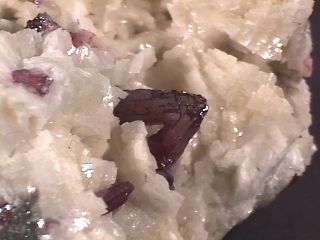

cin-9 ($105.00)
Tongren, Guizhou Province, China

CINNABAR specimen cin-10
$ 60.00
$ 60.00
Dims: 3.5" x 2.0" x 1.8" (8.9 x 5.1 x 4.6 cm)
Wt: 7.08 oz. (200.8 g)
Guizhou Province, China
A single complete Cinnabar crystal rests in a quartz-lined hollow on this specimen. It is the only complete, undamaged crystal on the piece. It has dimensions of approximately 0.3 x 0.2 x 0.2 (0.8 x 0.8 x 0.5 cm) and has an excellent trigonal prismatic form with a steep trigonal pyramidal termaination. It appears to be a penetration twin, judging by the protrusions that extend from the termination faces. It has the standard deep red coloration and bright, adamantine luster, and shows some noticeable transparence under bright light. There are several other red patches around it, denoting broken crystals, and the quartz bed on which they rest consists of scores of tiny hexagonal prisms that are colorless and quite clear. There is a small formation of white crystalline dolomite or calcite nearby, and the host rock is likely a limestone or calcareous shale.


cin-10 ($ 60.00)
Guizhou Province, China
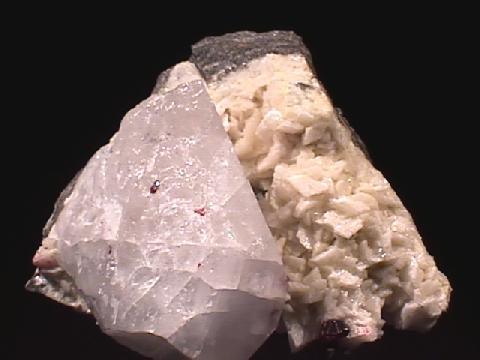
CINNABAR specimen cin-11
$ 90.00
$ 90.00
Dims: 3.3" x 2.9" x 1.8" (9.4 x 7.3 x 4.6 cm)
Wt: 6.83 oz. (193.7 g)
Guizhou Province, China
Three undamaged Cinnabar crystals rest on the dolomite-and-limestone host rock of this specimen. The largest of these is also the most exposed, and has dimensions of 0.4 x 0.2 x 0.2" (1.0 x 0.5 x 0.5 cm); the smallest of the crystals is deeply embedded in the dolomite base, and is barely visible. All show excellent trigonal prismatic form; the largest and smallest crystals show flat, basal terminations, whereas the other crystal has a warped form that makes it appear to be nearly octahedral! All have the deep red color that is standard for Cinnabar, and their luster is subadamantine-to-submetallic. Though it is difficult to determine, I am relatively certain that all are transparent and clear. The dolomite crust from which the Cinnabars extend is made up of dull, cream-colored intergrown rhombohedrons with curved edges. They, in turn, rest on a dark gray-brown base of dolomitic limestone. A large piece of a broken quartz crystal also rests on the dolomite crust, and appears to contain several incomplete Cinnabar crystals that were tr
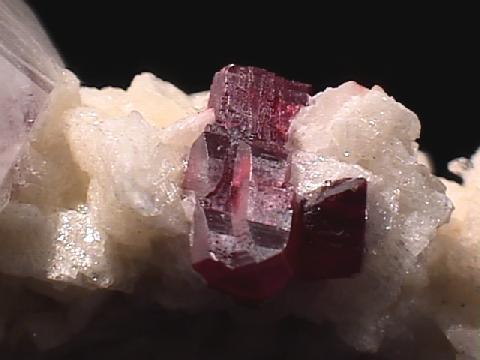

cin-11 ($ 90.00)
Guizhou Province, China
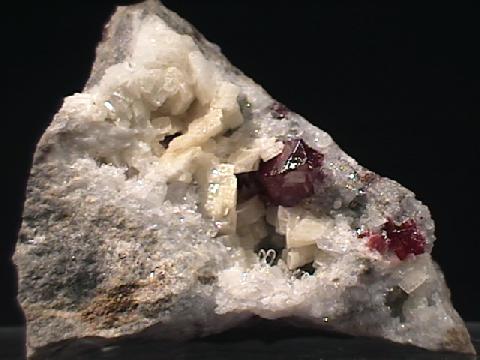
CINNABAR specimen cin-12
$ 110.00
$ 110.00
Dims: 2.4 x 2.1 x 1.7" (6.1 x 5.3 x 4.3 cm)
Wt: 3.8 oz. (107.4 g)
Tongren, Guizhou Province, China
This small hand specimen consists of a single trigonal prismatic Cinnabar crystal that rests on a dolomitic limestone base. It has visible dimensions of 0.5 x 0.2" (1.3 x 0.5 cm) and is in excellent condition- the only noticeable damage appears to be partly healed, and thus occurred prior to the mining of the specimen. Its edges are well-defined and its faces are clean, possessing an adamantine, submetallic luster. It has the standard deep red coloration of this mineral and is dimly transparent in halogen light. The crystal extends out of a hollow in the host rock that is line with many small, dull, cream-colored dolomite rhombohedrons and a few tiny quartz crystals. When looking down into the crevice, one can see another, incomplete Cinnabar crystal that is heavily intergrown with both the first crystal and the dolomites.


cin-12 ($110.00)
Tongren, Guizhou Province, China

CINNABAR specimen cin-13
$ 140.00
$ 140.00
Dims: 2.2 x 1.8 x 1.4" (5.6 x 4.6 x 3.6 cm)
Wt: 4.4 oz. (123.9 g)
Tongren, Guizhou Province, China
A single, well-formed Cinnabar crystal rests on the dolomite-and-limestone base of this specimen. The crystal has dimensions of 0.6 x 0.3 x 0.3" (1.5 x 0.8 x 0.8 cm), and is in very good condition, showing two small spots of minor damage, one at the base of its termination, and one at its tip. Its trigonal prismatic form is excellent; it occurs in the form of a penetration twin, so that when viewed from above, the termination is in the shape of a six-rayed star (see the close-up image). Though a few are disjointed, most of its surfaces are well-defined and its faces are striated but generally clean, and possess a submetallic and almost adamantine luster. It has the classic deep red coloration of Cinnabar and is translucent under bright light, showing patches of dim transparence in some areas. It rests on a bed of white dolomite that has good rhombohedral form but is heavily damaged, which in turn coats parts of the brown limestone base rock.


cin-13 ($140.00)
Tongren, Guizhou Province, China

CINNABAR specimen cin-14
$ 125.00
$ 125.00
Dims: 2.9 x 1.7 x 1.7" (7.4 x 4.3 x 4.3 cm)
Wt: 5.8 oz. (163.9 g)
Tongren, Guizhou Province, China
A single prismatic Cinnabar crystal rests on the gray limestone host rock of this small hand specimen. Though it is trigonal in form, it also is in the form of a penetration twin, so that it appears to have a six-rayed, pentagonal cross-section. It has visible dimensions of 0.5 x 0.2 x 0.2" (1.3 x 0.5 x 0.5 cm) and is in pristine condition, showing no human-induced damage whatsoever. Its form is also excellent, as all edges are sharp and all faces are striated but flat and clean, and possess a bright submetallic luster. Its red coloration is so deep that it is nearly opaque to all intents and purposes, and its metallic luster provides some interference. The crystal rests on a bed of heavily intergrown rhombohedral dolomite crystals and is adjacent to a cluster of small, prismatic quartz crystals (see the close-up image).


cin-14 ($125.00)
Tongren, Guizhou Province, China

CINNABAR specimen cin-15
$ 75.00
$ 75.00
Dims:3.2x2.5x1.9" (8.1x6.4x4.8 cm)
Wt: 9.0oz. (256g)
Feng Huang, Hunan province, China
A cavity in the matrix of this specimen host quartz, calcite and an excellent penetration twin crystal of cinnabar. This crystal is nearly 0.4" (1.0cm) in length. There is a very tiny chip on the back of this crystal; otherwise it is in excellent shape.


cin-15 ($ 75.00)
Feng Huang, Hunan province, China

$ 250.00
Dims: 2.87x1.81x1.06" (7.3x4.6x2.7cm)
Wt: 2.72oz. (77.1g)
Gong Kuan Mine, Tongren, Guizhou Provence, China
On a gray and white host rock rests a single, large, and nearly perfect twin crystal of cinnabar. The crystal has six ridges jutting to the point of the crystal, and each ridge terminates to a crystal face that tapers in towards the base of the crystal (rather like a 6-sided arrowhead). The cinnabar is very translucent and blood red when a bright light illuminates it from the rear. The surface appears slightly darker than the interior, judging by the light damage on the ridges and point. The host rock appears to be something gray covered with tiny quartz crystals (it may be simply quartz with black inclusions), plus a fair amount of white dolomite crystals providing a nice contrast for the cinnabar. The cinnabar crystal is classic in shape, well-formed, and measures 11mm from exposed base to tip and 10mm across.
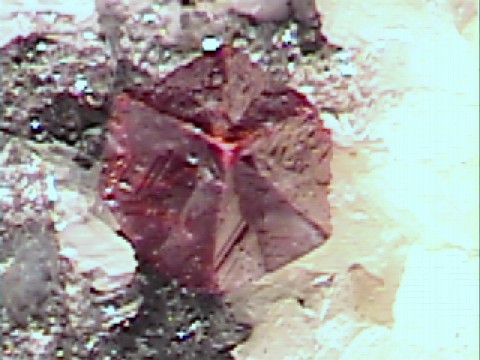

Gong Kuan Mine, Tongren, Guizhou Provence, China

CINNABAR specimen cin-17
$ 45.00
$ 45.00
Dims: 2.17x1.61x1.18" (5.5x4.1x3.0cm)
Wt: 3.00 oz. (85.0g)
Gong Kuan Mine, Tongren, Guizhou Provence, China
This gray host rock is largely covered with dolomite crystals, and sports a half dozen fragments of cinnabar crystals, plus one large and very nice one. While coated with a thin, almost metallic film that reflects silver in color, the cinnabar inside is actually almost transparent and a deep blood-red in color. The shape is a six-rayed twin crystal, typical of cinnabar twins, but is laying on its side and it is not symmetrical. The crystal does present well, as it contrasts nicely against the dolomite on which it sits.


cin-17 ($ 45.00)
Gong Kuan Mine, Tongren, Guizhou Provence, China
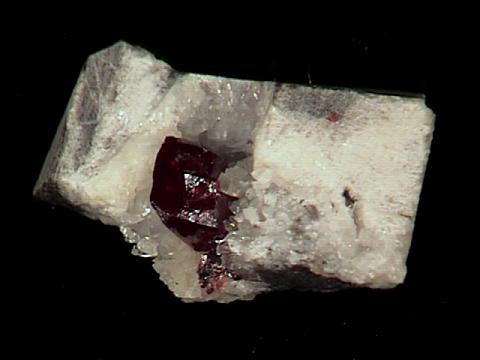
CINNABAR specimen cin-18
$ 40.00
$ 40.00
Dims: 1.41x0.93x0.86" (3.58x2.37x2.19cm)
Wt: 0.93oz. (26.4g)
Gong Kuan Mine, Tongren, Guizhou Provence, China
A diamond saw was used to cut away most of the host quartzite, exposing a cavity in which numerous tiny quartz crystals and a single large cinnabar crystal have grown. The cinnabar is technically a twin, but it rests on one side and is distorted enough that only its symmetry reveals its nature. The cinnabar has a metallic luster, is deep red, and I believe it is transparent, although the surface luster makes it very difficult to see into the crystal. Careful examination with a loupe reveals several faces that expose an internal red glow. This is a fine crystal, even if it is not a perfect twin.


cin-18 ($ 40.00)
Gong Kuan Mine, Tongren, Guizhou Provence, China

CINNABAR specimen cin-20
$ 30.00
$ 30.00
Dims: 1.53x1.24x0.74" (3.89x3.15x1.89cm)
Wt: 1.15oz (32.5g)
China
This specimen of cinnabar displays a number of three-sided pyramids (at least one crystal displays more of the full 6-sided scalahedron form). The crystals are striated, appear transparent to translucent, with a deep red color, and a sub-metallic luster. The host rock has several other minerals present, including many small quartz crystals, some calcite, and a black mineral that is likely another metallic sulfide.


cin-20 ($ 30.00)
China
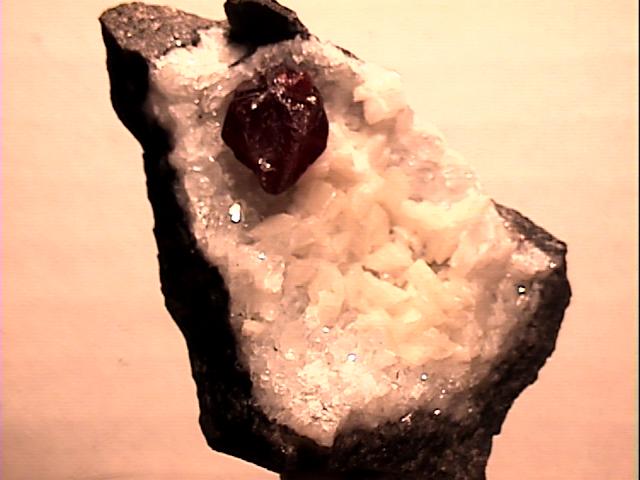
CINNABAR specimen cin-19
$ 35.00
$ 35.00
Dims: 1.98x1.51x0.78" (5.02x3.83x1.98cm)
Wt: 1.19oz. (33.7g)
Gong Kuan Mine, Tongren, Guizhou Provence, China
A nearly perfect twinned crystal of cinnabar rests on its side on this specimen. It is deep red, translucent but nearly transparent, and has a metallic luster. When examined under a bright light, bright flashes of red suggest transparency. It is accompanied by a few dozen small crystals that look like a white dolomite, and both of these rest on a bed of tiny quartz crystals.


cin-19 ($ 35.00)
Gong Kuan Mine, Tongren, Guizhou Provence, China

CINNABAR specimen cin-21
$ 50.00
$ 50.00
Dims: 2.31x1.94x1.04" (5.86x4.93x2.65cm)
Wt: 3.69oz (104.5g)
Tongren, Guizhou Province, China
Two nice cinnabar crystals (plus a half-dozen fragments) are nested in a base of white dolomite crystals. The cinnabar is very red, transparent, and displays a typical metallic luster. I am guessing about the transparency - the surface texture is sufficiently pitted (and with enough of a metallic hue) to hide the interior, but light seems to shine through the crystals well enough that I suspect they are internally transparent. At the very least, they are highly translucent. There are also some odly shaped highly transparent quartz crystals, and close inspection of the dolomite shows that much of it is coated with a fine druze of transparent crystals, almost certainly quartz crystals which are on their sides.


cin-21 ($ 50.00)
Tongren, Guizhou Province, China